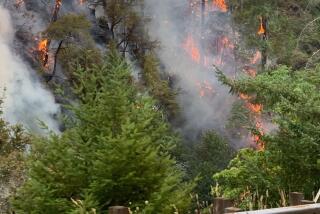Crews Fight to Keep Fuel Spill Out of Alaska Refuge
ANCHORAGE â Railroad crews were struggling Thursday to keep an estimated 120,000 gallons of spilled jet and diesel fuel from seeping through one of the richest waterfowl nesting areas in North America.
The fuel was spilled Monday when 19 tanker cars on a state-owned Alaska railroad jumped the tracks and overturned along a remote stretch of line 40 miles southwest of Fairbanks.
The accident occurred on the edge of a vast wetlands system that is the spring and summer home to an estimated 12 million ducks, geese and other migratory birds.
Beaver ponds alongside the track kept most of the fuel from flowing into a series of marshes, meandering creeks and lakes nearby, state environmental authorities said. The beaver pools, formed by stick-and-mud dams, gave railroad workers time to move cleanup equipment into place and begin pumping up the spilled fuel.
âBut for the grace of God, and a few beavers, weâd have a major, major problem,â said Rex Blazer, director of the Northern Alaska Environmental Center, a private Fairbanks conservation group.
By Thursday, the derailed cars had been cleared from the tracks, and the line reopened, although much of the spilled fuel in the ponds had not yet been removed, according to Pete McGee, the regional supervisor for the Alaska Department of Environmental Conservation.
Wildlife biologists and others were concerned that large amounts of fuel could still seep into a nearby creek and spread quickly through the spongy marsh if not cleaned up soon.
There were no reports of dead animals or fish, but patches of oily sheen were spotted several miles downstream from the derailment, and officials reported a mixture of fuel and water was leaking through one of the beaver dams at a rate of about 200 gallons a minute.
âItâs been going pretty slowly, and weâve been encouraging the railroad to get into higher gear,â said Chuck Kleeschulte, a spokesman for the Department of Environmental Conservation. âTheyâve been having a number of problems. . . . They didnât have the right hoses. Their nozzles didnât work.â
The fuel, being shipped south to Anchorage from a refinery east of Fairbanks, is more toxic than crude oil. But it is also lighter and will evaporate within days if exposed to air, officials said.
More than 11 million gallons of crude oil leaked into Alaskaâs Prince William Sound when the Exxon Valdez ran aground a year ago in Americaâs biggest oil spill. That spill aside, this weekâs train accident ranks among the largest toxic spills ever in Alaska, officials said.
No one was hurt in the derailment. A spokeswoman for the railroad, which runs a single line between Fairbanks, Anchorage and the southern coast of the state, said no cause had been established. A faulty switch is suspected.
The spill occurred on the edge of the Minto Flats State Game Refuge, a 500,000-acre block of wilderness that is home to northern pike and other freshwater fish, as well as river otters, wolves, black bears and moose. A recent survey by the Alaska Department of Fish and Game found an average of 213 nesting ducks per square mile, one of the highest concentrations on the continent, and the area is one of the richest habitats in the world for trumpeter swans.
Meanwhile, another worry was that brush fires could spread into the wetlands and reach the spilled fuel. Crews have been battling wild fires all week about 20 miles south of the derailment.
More to Read
Sign up for Essential California
The most important California stories and recommendations in your inbox every morning.
You may occasionally receive promotional content from the Los Angeles Times.









